Just like the Palais, the Luxembourg Garden is a historic garden.
Some of its trees date back to the early 19th century (plane trees in the Médicis fountain and the allée Delacroix), others may have belonged to Marie de Medici in the 17th century (orange trees in crates), while others in the orchard bear witness to the garden's horticultural tradition, which dates back to the 13th century (fruit varieties of the Carthusian monks).
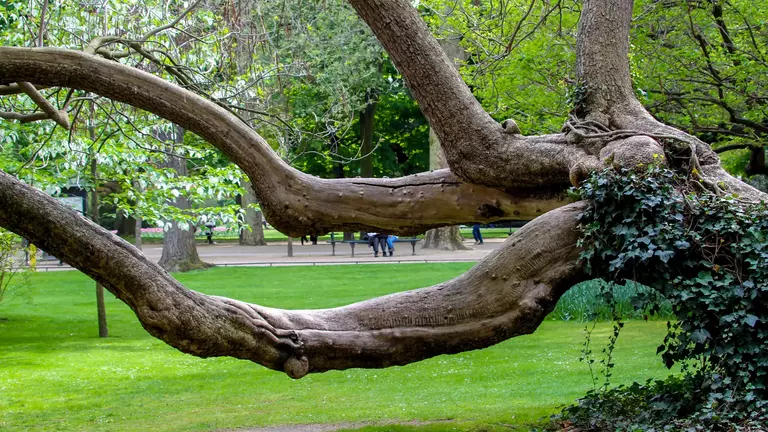
Trees explained
Find out more about the remarkable trees in the Luxembourg Garden:
- Æsculus pavia - Red Pavia (Hippocastanaceae): cousin of the chestnut trees.
- Albizia julibrissin - Silk Tree or Constantinople Acacia (Leguminosae): pink flowers from June to August.
- Cedrus atlantica - Atlas Cedar (Pinaceae).
- Celtis australis - Provence hackberry (Ulmaceae).
- Cercis siliquastrum - Judas tree (Leguminosae): pink flowers on the wood in spring; a very rare white-flowered specimen can be found in the garden (near the entrance to the Odeon).
- Davidia involucrata - Handkerchief Tree (Nyssaceae): blooms in spring with spectacular white bracts resembling handkerchiefs hanging from the branches.
- Fagus sylvatica 'Atropurpurea' - Purple beech (Fagaceae): a specimen probably 140 years old can be found in the garden (between the Odéon and Médicis entrances).
- Fagus sylvatica 'Laciniata' - Laciniated beech (Fagaceae): probably 140 years old.
- Ginkgo biloba - Arbre aux quarante écus (Ginkgoaceae): deciduous conifer introduced to France from China in 1727. The female plant bears repellent-smelling fruit in autumn.
- Kœlreuteria paniculata - Soap tree (Sapindaceae): native to East Asia; yellow flowers in June/July, decorative fruit in autumn, slow-growing.
- Morus alba - White Mulberry (Moraceae): pinkish-white fruit in August; its leaves are used as silkworm food.
- Parrotia persica (Hamamelidaceae): beautiful autumn foliage.
- Sequoiadendron giganteum - California Sequoia (Taxodiaceae): planted in 1975, can reach a height of 90 m in California, with a lifespan of over 3,000 years.
- Thuja plicata 'Atrovirens' - California red cedar (Cupressaceae): planted in 1975, can reach a height of 60 m, growing in isolation by natural layering of low branches.
- Ulmus glabra 'Pendula' - Weeping elm (Ulmaceae): the last elm in the garden, all the others were felled in the 1970s (due to graphiosis).
- Zelkova crenata - Siberian elm (Ulmaceae): belongs to the same family as the elm, but is not affected by graphiosis.
Trees in photos
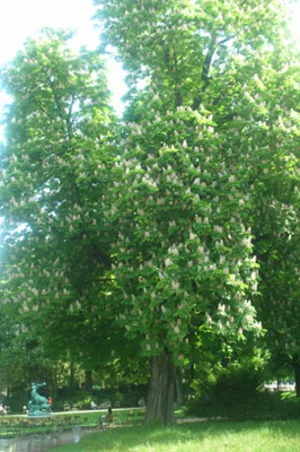
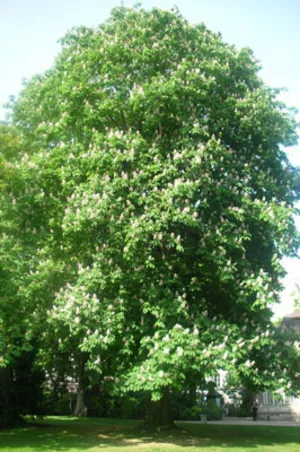
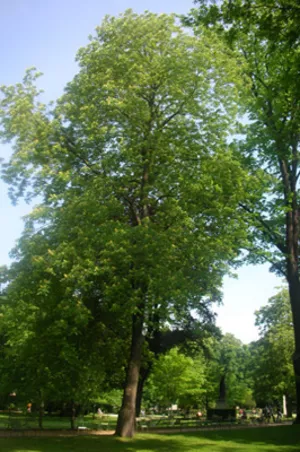
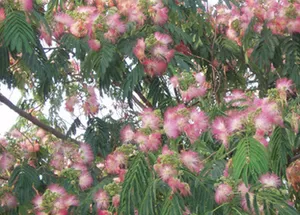

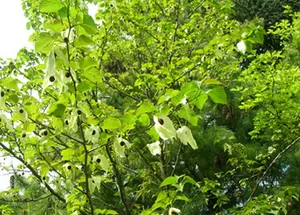
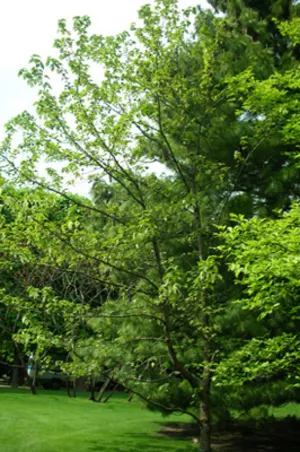
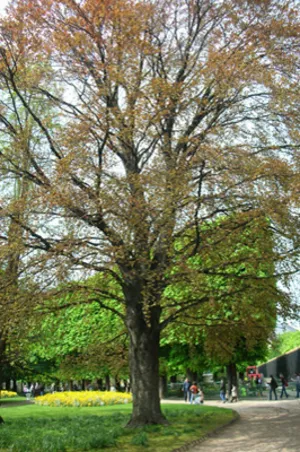
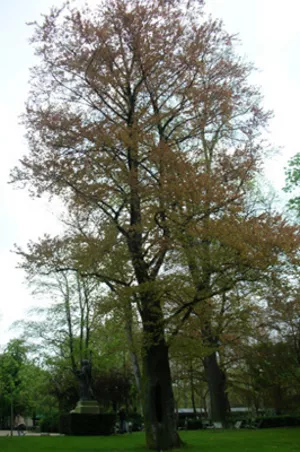

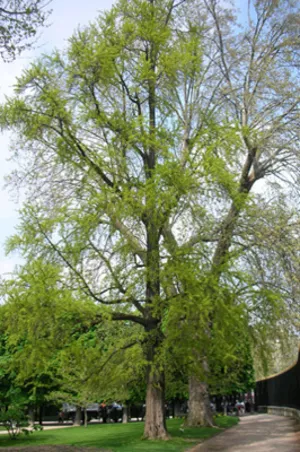
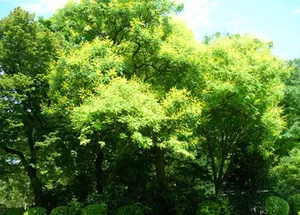
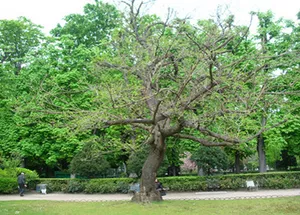
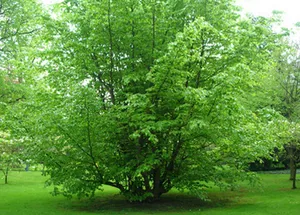
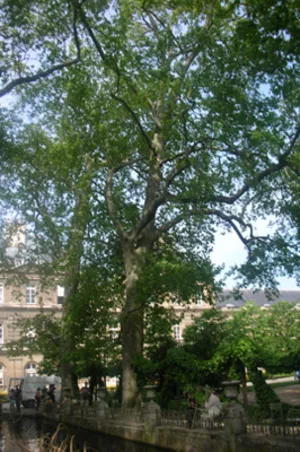
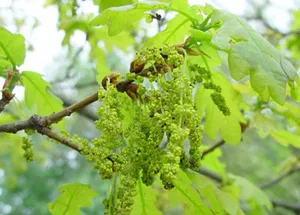
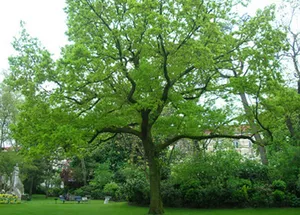
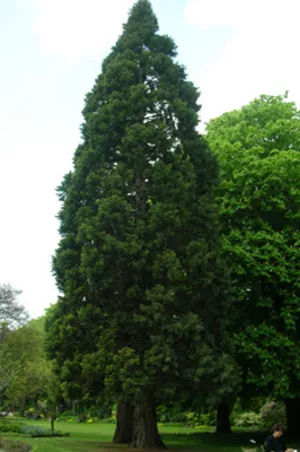
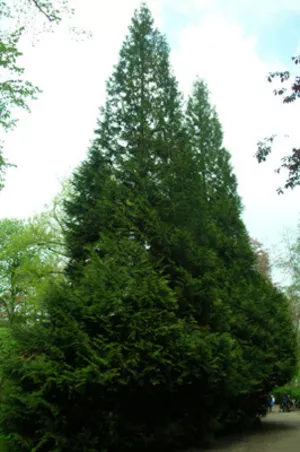
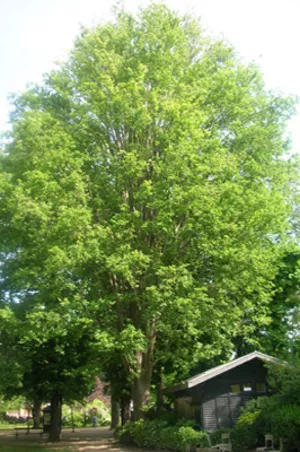
The Garden's enamelled plaques
Discover the texts on the enamelled plaques in the Garden:
Æsculus hippocastanum L.
Horse Chestnut - Hippocastanaceae
- origin: Balkans
- etymology: æsculus = Latin name of a holm oak with edible acorns dedicated to Jupiter
hippocastanum = Latin for 'horse chestnut
It came to Paris from Asia in 1615, but was not introduced to the Luxembourg Gardens until the second half of the 17th century. Thanks to its rapid growth, it gradually replaced many of the elms that Marie de Médicis had had planted when the garden was created.
In the city, this tree suffers greatly from the drought and arid atmosphere, which cause its leaves to turn yellow from July-August onwards.
Quercus robur L.
Pedunculate oak - Fagaceae
- origin: Europe
- etymology: quercus = Latin name for oak
robur = One of the rare oaks in the Luxembourg Gardens. A common species, the pedunculate oak is widespread in European forests, except in the far north of the continent. It can grow to between 25 and 35 metres in height and live for between 500 and 1,000 years.
It provides excellent timber and is much sought-after by cabinet-makers.
Sequoiadendron giganteum (Lindl.) Buch
Giant Sequoia - Taxodiaceae
- origin: California
- etymology: sequoia = name of the Indian chief who created the Cherokee alphabet
dendron = from Greek 'tree
giganteum = from Greek 'very large
This species was only discovered in 1833 in the Sierra Nevada and introduced to Europe in 1860.
It reaches a height of 100 m in California, making it one of the giants of the plant kingdom. In France, the oldest introduced trees are currently over 40 m tall.
Extremely long-lived, more than 2,000 years, its very thick, fibrous, reddish-brown bark is supple under finger pressure, enabling it to withstand fires and extreme cold.
Morus alba L.
White mulberry - Moraceae
- origin: China
- etymology: morus = from Greek 'morea' mulberry tree
alba = Latin for 'white
Introduced to Provence in 1494, this tree was already cultivated for its foliage in Mesopotamia and Ancient Egypt, while the Chinese have been using it for over 5,000 years. The leaves were used as food for silkworm caterpillars (Bombyx mori). Today, it is used only as an ornamental tree providing pleasant shade.
In August-September, the whitish to purplish-pink blackberry-shaped fruits appear. They are edible but bland, unlike those of the black mulberry (Morus nigra).
Zelkova carpinifolia (Pall.) C. Koch
Siberian elm - Ulmaceae
- origin: Caucasus and Iran
- etymology: from dzelva = local name for this tree in the Caucasus
carpinifolia = from Latin 'with hornbeam leaves'.
Introduced to Europe in 1760 and to Paris in 1782, this long-lived tree has an original habit, with a stocky trunk topped by numerous upright branches that are sometimes fused together. Its foliage has a remarkable autumn colour.
Although it belongs to the same family as the elm, it is not affected by graphiosis (Ceratocystis ulmi).
Platanus x acerifolia (Ait.) Willd.
Maple-leaved plane - Platanaceae
- origin: hybrid plant of unknown origin
- etymology: platanus = from the Greek 'platys', broad and flat (alluding to the shape of the leaves)
acerifolia = from Latin 'maple leaf'.
The oldest plane trees in the Médicis fountain were planted around 1810 and lined a path leading to the building.
In 1862, the creation of the rue de Médicis, which was largely laid out to the detriment of the garden, meant that the fountain had to be dismantled and moved 30 m closer to the palace. Only the trees in front of it were kept.
This plane tree, wedged between the garden gate and the back of the fountain, is the only visible trace of the relocation of the Medici fountain.
Platanus x acerifolia (Ait.) Willd.
Maple-leaved plane - Platanaceae
- origin: hybrid plant of unknown origin
- etymology: platanus = from the Greek 'platys', broad and flat (alluding to the shape of the leaves)
acerifolia = from Latin 'maple leaf'.
Unknown in the wild, it is thought to be either a hybrid between Platanus occidentalis L. from North America and Platanus orientalis L. from the Balkans, or an ancient cultivated form of the latter.
It is one of the trees that best withstands atmospheric pollution and severe pruning. Its fruits, characteristic of the Platanus genus, are hairy achenes packed close together. They form a compact ball that lasts until spring.
Fagus sylvatica 'Atropunicea' L.
Purple Beech - Fagaceae
- origin: Europe
- etymology: fagus = from Greek 'phègos', holm oak with edible acorns
sylvatica = from Latin 'forest'.
The 'Atropunicea' variety is one of many forms of beech with purple ornamental foliage, here grafted onto the standard species Fagus sylvatica (graft bead halfway up the trunk).
It is thought to be a mutation observed in Switzerland in 1680, then in Germany around 1772, in natural stands of beech.
Its purple colouring is darker and more even than that of the 'Purpurea' cultivar, which is more common because it is propagated from seed.
Ginkgo biloba L. - male plant
40 écus tree - Ginkgoaceae
- origin: China
- etymology: ginkgo = original Asian name for the tree meaning 'silver apricot
biloba = Latin for 'two-lobed' (an allusion to the shape of the leaves)
Introduced to Europe in 1727, Ginkgo biloba trees are the last representatives of a family that appeared in the secondary era. This unique species, known as dioecious, has separate male and female plants, which only flower after 45 to 50 years.
On this male tree, the flowers appear in spring in long, drooping catkins. In autumn, the leaves often fall before the female tree
Ginkgo biloba L. - female foot
40 écus tree - Ginkgoaceae
- origin: China
- etymology: ginkgo = original Asian name for the tree meaning 'silver apricot
biloba = from Latin 'with two lobes' (an allusion to the shape of the leaves)
Sometimes referred to as a 'living fossil', this tree is one of the oldest representatives of the flora of the secondary era. Male and female inflorescences appear in spring on separate trees.
On this female tree, the flowers appear in the axils of the short branches. The yellowish fruit looks like a mirabelle plum, but when ripe has a very strong, nauseating odour.
The foliage takes on a spectacular golden colour in autumn.